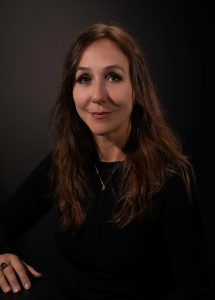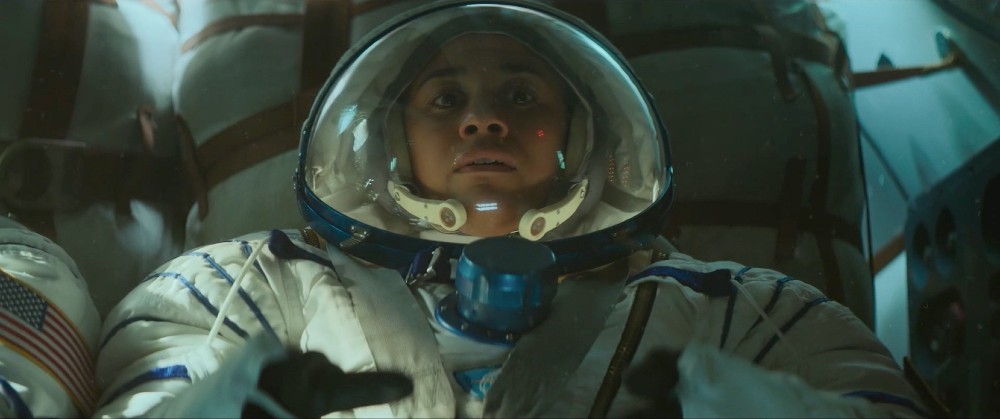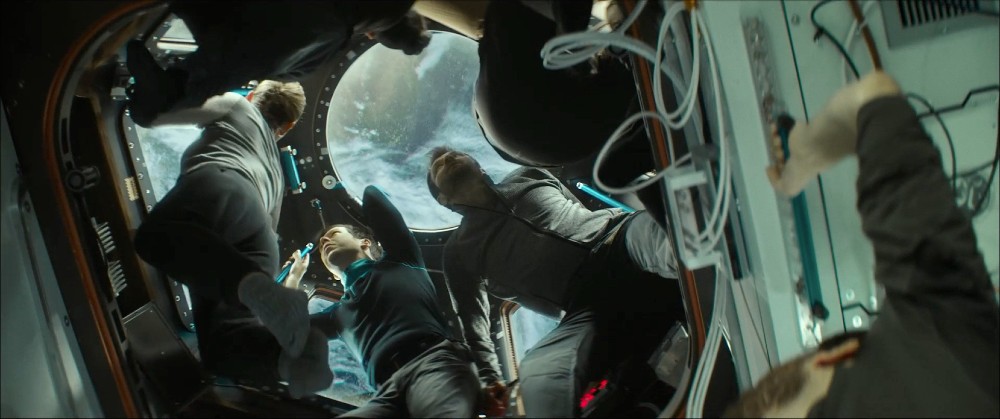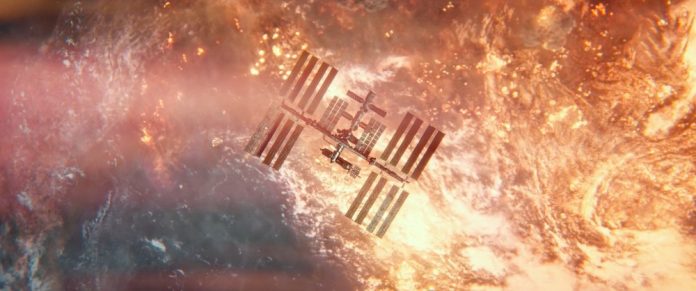Imagine being aboard the International Space Station orbiting hundreds of miles above the earth, when something happens on earth that changes your dynamics with the others up there in space with you.
That’s the premise for I.S.S., a new outer space thriller directed by Gabriela Cowperthwaite, who is probably best known for her critically acclaimed documentary, Blackfish, which had a huge impact on Seaworld, and its use of orcas to entertain the masses, often to the detriment of the marine mammal population. Even if you’ve seen the filmmaker’s other narrative films – her last one was 2019’s Our Friend, which played a number of festivals and then got delayed to COVID – I.S.S. seems like such a different experience.
It stars Oscar winner Aria DeBose (West Side Story) as Dr. Kira Foster, an American scientist sent to the I.S.S. to do some research along with two other Americans (played by Chris Messina and John Gallagher Jr.) and their three Russian counterparts, played by Masha Mashkova, Costa Ronin, and Pilou Asbæk. After seeing potential nuclear strikes on earth, each team receives orders from command to take control of the I.S.S. that creates more friction and tension amongst all of them.
Above the Line got on Zoom with Cowperthwaite to talk about directing what turned out to be a very different movie for her with a LOT more visual effects work than anyone could have expected.

Above the Line: I missed this at Tribeca last year, but I saw the trailer for it, and when I saw that you directed, I was surprised, because I mostly knew you from Blackfish, but I had also seen Megan Leavey and Our Friend, and I.S.S. seems so different from everything else you’d done. How did the screenplay come your way, and what interested you in taking it on?
Gabriela Cowperthwaite: Yeah, I mean, it definitely is. This isn’t the type of script that fills my inbox, so it was exciting that way. It was neat to be able to look at the plot. I just read it, and I just thought the plot was very rad, and I was like, “Why hasn’t anyone done this before? This is such a cool conceit.” But I also thought to myself, “I could take all the authenticity and real-life storytelling stuff that I’ve done in the past with that world – real-life storytelling, documentary – and bring that genuineness and authenticity to this very sci-fi, world, just put it up in space, which was super-exciting. It was something I wanted to do, and I had not been given a chance to do, coupled with what I knew I could do. Those two worlds together were what made this an exciting challenge.
ATL: You mentioned sci-fi, so do you consider this science fiction? The I.S.S. is a real thing, as are the astronauts and scientists, and our conflict with Russia keeps on happening.
Cowperthwaite: I love that you say that, because I’ve kept calling people out on that genre. There’s no fiction about it. It’s fiction, like any other feature film is a fiction, but it’s actually a real thing. I think things that happen in space might just kind of fall into that genre, but I think of it is a dramatic thriller in a lot of ways.
ATL: When you read the script and decided you were going to give this a go, what was the first thing you had to figure out, besides the obvious thing like the amount of VFX that would be required?
Cowperthwaite: I think the biggest one for me was honestly, the technicalities and all that, it’s all scary, because it’s a world I hadn’t really lived in before. But then I thought to myself, what I had to do was essentially shot list every single thing with my cinematographer Nick Matthews. We shot listed every single second, because you have to walk in to the ceilings being flown off of certain pods, you have to have your actors tethered in a very specific way, so that they don’t cross each other and get tangled. Everything relies on visualizing every single second before you even walk in there. That’s sort of something I’ve done anyway, with shot-listing my stuff in the past, but there was no room for agility this time. That was kind of like this new thing, that was something I hadn’t done in such a regimented way before. There was that, but honestly, I really just had to do this research, because I didn’t know anything about the ISS. I didn’t know it travels 17,000 miles per hour. I didn’t know that. There were all these things I didn’t know about sleeping up there, like what happens to our bodies. Learning about all that was just so, so cool. Delving into that world that I just knew nothing about was incredibly exciting.
ATL: I assume you had to build this on a stage, and it’s mostly interiors of the I.S.S., but there are some exteriors in space. How did you go about that with your production designer?
Cowperthwaite: Built on a stage for sure, so basically, a big stage in North Carolina. One of my directives for the whole thing was that I wanted it to look as much like the real ISS as possible. Geoffrey Wallace, our production designer, knew exactly what I was going for. He built these actual pods on the stage that weren’t unlike the real ISS pods, built them enough with a wall that could fly off to fit the camera. They were still really claustrophobic, and the ceilings were off, obviously, because you had to tether and move people in zero gravity. Really, it was just built on set, and we had these different pods that moved here and there on wheels, and that’s how we shot the film.

ATL: I’m sure you get a lot of questions about casting Ariana DeBose, because obviously, people know her from West Side Story or hosting the Tonys. We know her for her voice, so if I watched it not realizing that was her, I’d probably have to look it up. How did you end up casting her in the lead role?
Cowperthwaite: So she auditioned for it, which is just such a complete joke, because she had not won her statue yet, so she was sort of like reading for me, and she was amazing. I think she was just in West Side Story, so must be amazing, and yet, I loved her. She was just making choices in things where you could just see what she could do. She read, and she knocked it out of the park for me, as being a scientist, not this big, glossy, shiny Anita. I saw that she could have that nuance. I also was kind of excited by her physicality [being] this dancer, right? I just knew that Dr. Kira Foster is going to be tethered, going to be moving in zero gravity. There’s just a lot that I’m asking my actors to do, and these are really uncomfortable tethers. They really have to understand and be in their bodies, so I knew she would get that part, but it was really just the nuance in her reading, and taking direction and asking, “Am I getting it? Can you give me feedback? Could I try something different?” There was something about her directability that is really always exciting for a director.
ATL: Was it harder to find and cast the Russian astronauts for this?
Cowperthwaite: Masha [Mashkova] was harder to find, and she was like this gem of find. I can’t believe this is one of the first things she’s done in a feature context in this country. Her dad’s a famous actor in Russia, so she’s very famous there, and I didn’t know about her. She came to me through someone who knew someone, and she did a reading. We’d actually had somebody else cast for that role who fell sick, and that person suggested Masha, so it’s kind of this beautiful thing that happened there. And then Costa [Ronin], I’d seen him in The Americans; he was Nicholai. I also love the fact you would never question whether this guy’s a Russian commander, but what I love the most about Costa is these moments that he almost came up with himself, which were, like, what it’s like to smell the trees in Siberia. And these little human moments of laughter and all this stuff that you’re never sure if someone can do and kind of can go there, or if they need to be that commander type and kind of game face it. He had all the colors in the spectrum. So that was exciting.
ATL: How did you get the actors prepared for that Zero Gravity? What was involved? You mentioned they were tethered, so were they literally being dragged up and down and all around to create that look?
Cowperthwaite: Essentially like marionettes, basically is how it is, they’re really tethered. And then, the tether is incredibly uncomfortable, and their harness is tethered to a gantry, basically, and they’re moved by the stunts team in very specific, predetermined ways. Technically, it’s just like so much to have in your head, and then, one little thing goes wrong, and we have to reset. Oftentimes, they’re just uncomfortable and need a break. It just was a lot packed into our 30-something days, but they all got there, and they all wanted it to look realistic. They just went with the core strength thing for about two and a half months.

ATL: I imagine there are a lot more visual effects involved in this movie than probably all the other movies you’ve done combined. Did you have green screen, did you try to use virtual production, how did you go about integrating all the VFX involved?
Cowperthwaite: It was by far the craziest part of it. You finally understand why people don’t do zero gravity movies. It was just so impossible to imagine how many VFX… I mean, every single second, you’re painting something, out every single second, every single frame, because of the tethers. That was really a huge, huge challenge. It was year, basically, in post. You think it’s quite simple, just painting this stuff away. We have green screen everything, everything’s ready, it doesn’t really matter, right? It is frame by frame meticulous work, and it’s not cheap. It’s on an indie budget the whole time, so that part, I think, was a surprise for not only me, but our producers, for everyone who had not made zero gravity films.
ATL: When Tom Cruise wants to make a space movie, he just gets in a spaceship. You shot this a while ago, right? Before the Russian invasion of Ukraine?
Cowperthwaite: It was shot in, I want to say 2021. During the pandemic, everybody with masks, double-masked, the whole nine, and during post, Ukraine and Russia, that happened after we had filmed everything, so it felt very surreal. A lot of questions were raised. In my mind, it was, “Is this a responsible film to have out right now? What are we trying to say here?” I sort of knew what I was trying to say with the film anyway, about the brunt of these types of things falls on the little people. That’s exactly what we were showing. It wasn’t a political movie, right? It just happened to be a movie where some politics happen, and you’re watching that bear itself out with six people and how they coexist. To me, that part stays true, no matter what happens in the world.
ATL: Is this the first time you worked with Anne doing your music? How did you find her? I thought the music and overall sound was incredible.
Cowperthwaite: I’m so happy to hear that. Yes, Anne Nikiten just blew my mind here. I saw her work — she had done a ton of films before, but a couple I had seen that were references for this film. I’ve never had that experience where you give a note, and what they do with that note is 10 times better than what you imagined they could do. I had a big temp track on there that was very aspirational, and also very different. I really wanted almost a primal sound instead of really, I don’t know, sci-fi, big orchestral stuff, or computery digital sounds that people associate with sci-fi. I didn’t want any of that. I wanted this primal, earthy thing to just play against that, and she just sort of got it at the get-go. A lot of the sound design is actually her in some of these sections. I was very, very excited to be working with her.
ATL: I’m always asking the composers I interview about how much the filmmakers they work with know how to communicate about the music, and it’s amazing what they can take and turn it into such a terrific score.
Cowperthwaite: That’s exactly what it is. They can translate language into music. You say something, they hear it. I had that expert means with her, for sure.
ATL: Are you generally going to go back and forth between narrative and documentary?
Cowperthwaite: My experience with docs is such that, like… they get me in trouble. And so, I can do features, I don’t make enemies, right and like, in the doc world, it’s a different feeling. There’s trepidation. So I joke and say that features allow me to make less enemies, but really, I actually just love doing both and the bottom of all of it, I just love being a storyteller. I have things that I think cross-cut all those genres. I know what real looks like; I want real genuine authenticity all that stuff, and hopefully, I want films to maybe say something a little bit. Those types of things kind of stay, but I would love to play in both worlds, if both worlds have me.
I.S.S. opens nationwide on Friday, Jan. 19



